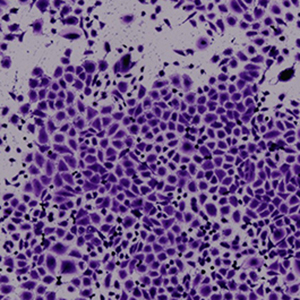The role of miR-143-3p/FNDC1 axis on the progression of non-small cell lung cancer

Accepted: 22 March 2023
HTML: 18
All claims expressed in this article are solely those of the authors and do not necessarily represent those of their affiliated organizations, or those of the publisher, the editors and the reviewers. Any product that may be evaluated in this article or claim that may be made by its manufacturer is not guaranteed or endorsed by the publisher.
Authors
The study aimed to explore the functional role of fibronectin type III domain containing 1 (FNDC1) in nonsmall cell lung cancer (NSCLC), as well as the mechanism governing its expression. The expression levels of FNDC1 and related genes in tissue and cell samples were detected by qRT-PCR. Kaplan-Meier analysis was employed to analyze the association between FNDC1 level and the overall survival of NSCLC patients. Functional experiments such as CCK-8 proliferation, colony formation, EDU staining, migration and invasion assays were conducted to investigate the functional role of FNDC1 in regulating the malignancy of NSCLC cells. Bioinformatic tools and dual-luciferase reporter assay were used to identify the miRNA regulator of FNDC1 in NSCLC cells. Our data revealed the upregulation of FNDC1 at mRNA and protein levels in NSCLC tumor tissues cancer cell lines, compared with normal counterparts. NSCLC patients with higher FNDC1 expression suffered from a poorer overall survival. FNDC1 knockdown significantly suppressed the proliferation, migration and invasion of NSCLC cells, and had an inhibitory effect on tube formation. We further demonstrated that miR-143-3p was an upstream regulator of FNDC1 and miR-143-3p expression was repressed in NSCLC samples. Similar to FNDC1 knockdown, miR-143-3p overexpression inhibited the growth, migration and invasion of NSCLC cells. FNDC1 overexpression could partially rescue the effect of miR-143-3p overexpression. FNDC1 silencing also suppressed the tumorigenesis of NSCLC cells in mouse model. In conclusion, FNDC1 promotes the malignant prototypes of NSCLC cells. miR-143-3p is a negative regulator of FNDC1 in NSCLC cells, which may serve as a promising therapeutic target in NSCLC.
Ethics Approval
the study was approved by the Ethics Committee Board of Affiliated Hospital of Chifeng University, All animal procedures were approved by the Animal Care and Use Ethical Committee of Affiliated Hospital of Chifeng UniversityHow to Cite

This work is licensed under a Creative Commons Attribution-NonCommercial 4.0 International License.
PAGEPress has chosen to apply the Creative Commons Attribution NonCommercial 4.0 International License (CC BY-NC 4.0) to all manuscripts to be published.

 https://doi.org/10.4081/ejh.2023.3577
https://doi.org/10.4081/ejh.2023.3577






